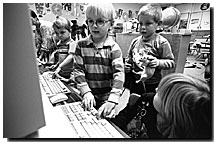 Lusk elementary school students in Robyn Heth's class are wired to other schools via computer networks. The kids are as comfortable in cyberspace as they are in the classroom. (Photograph by Lynn Johnson)
Lusk elementary school students in Robyn Heth's class are wired to other schools via computer networks. The kids are as comfortable in cyberspace as they are in the classroom. (Photograph by Lynn Johnson)
|
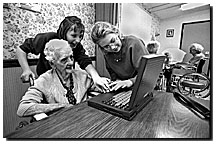 Lusk's drive down the information superhighway isn't just for the young. Danielle Sigvarsten, 12
Lusk's drive down the information superhighway isn't just for the young. Danielle Sigvarsten, 12
(at left), and Lindsay Webb, 12, are introducing
Ocea Lliss, 103, to the digital world. The young- sters expanded the screen's display type to 72 points so Ocea could read it more comfortably. (Photograph by Lynn Johnson)
|
|
The mayor has corralled enough interest and money to link Lusk's businesses, schools, government offices, and 600 homes with coaxial and fiber-optic cable so they, too, can enter the Information Age via the Internet. "It was a matter of survival for us," says the 60-year-old mayor. "Getting wired is our hope for the future." Lusk's last boom, during the 1920s from cattle and oil production, transformed the dusty high-plains village into a metropolis of 10,000 people. Since then, the population has dwindled down to 1,504 at last count. By connecting electronically, the Mayor and his backers hope to stop the hemorrage of young people from Lusk that has sapped the vitality from so many otherAmerican towns. With his can-do spirit, the seven-term mayor convinced US West, Wyoming's main phone company, to lay cable from the nearest highway into Lusk. Then he roped in a $295,000 grant to pay for wiring the town itself. Established firms are beginning to thrive because of the connections, Whiteaker says. He pictures new businesses, such as catalog ordering and telemarketing, moving in. Already, two companies have been lured by Lusk's rare combination of high connectivity and low-cost living. One firm is a company specializing in electronic components, including those for the White House security gates. "There's a lot of interest, especially from other rural communities," says Donald. "They wonder how in the hell I did it. 'It's simple,' I tell them. 'I just went out and did it.' "
|
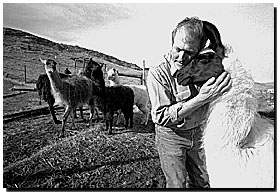 Gene Kupke has created a home page for his llama farm. (Photograph by Lynn Johnson)
Gene Kupke has created a home page for his llama farm. (Photograph by Lynn Johnson)
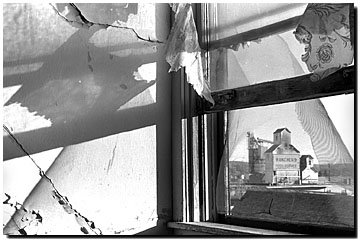 Mayor Donald Whitetaker has worked to halt Lusk, Wyoming's deterioration into prairie dust by wiring the entire town. (Photograph by Lynn Johnson)
Mayor Donald Whitetaker has worked to halt Lusk, Wyoming's deterioration into prairie dust by wiring the entire town. (Photograph by Lynn Johnson)






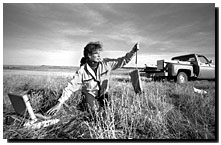
 Lusk elementary school students in Robyn Heth's class are wired to other schools via computer networks. The kids are as comfortable in cyberspace as they are in the classroom. (Photograph by
Lusk elementary school students in Robyn Heth's class are wired to other schools via computer networks. The kids are as comfortable in cyberspace as they are in the classroom. (Photograph by  Lusk's drive down the information superhighway isn't just for the young. Danielle Sigvarsten, 12
Lusk's drive down the information superhighway isn't just for the young. Danielle Sigvarsten, 12